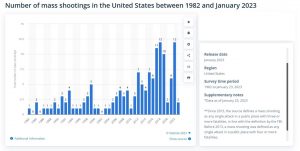The debt ceiling debate ignores the fact that the federal government has spent more than the revenues it receives for generations.
You need to SUBSCRIBE to Life, Liberty & Property. Read previous issues.
IN THIS ISSUE:
One-Sided Debt Ceiling Debate
Bad Aim with Gun Control
Honors for All, or Honors for None
Anti-SLAPP Happy
One-Sided Debt Ceiling Debate

There are currently two positions on the federal debt ceiling. Or one, if you want to be accurate.
The White House wants a clean lifting of the ceiling, and president and his team would prefer that it be eliminated permanently. Whatever Congress and the president want to spend, they should not have to raise taxes for it, the thinking goes. This is in accord with Modern Monetary Theory, the idea that government spending invariably stimulates the economy and you use tax increases to put the brakes on inflation.
As Mises Institute President Jeff Deist notes, this means “Sovereign government treasuries can create and spend as much money as they like to stimulate growth, especially when the economy is underperforming. If inflation spikes, taxes can be imposed to take money out of the economy.”
Biden and the congressional Democrats present current spending levels as inviolate and argue that any cuts will be disastrous for the American people. Federal spending has increased from 20 percent of GDP in 2015 to approximately 25 percent now. If you remember the mass poverty, starvation, and homelessness the nation suffered in 2015, you can understand why Biden is so staunch in his refusal to cut federal spending.
Note that federal revenue has historically hovered around 17.4 percent of GDP for the past half-century, no matter what the tax rates have been (see figure below). Debt is essential if you are going to spend more than that—and especially if you want to spend 7 percentage points more of GDP than the norm. Meaning, especially if you are wildly irresponsible.

Source: usgovernmentrevenue.com
Congressional Republicans and others fancifully designated as fiscal conservatives (of which there are in fact none in power in Washington, D.C.) believe that the federal government is spending too much money, which of course it is, and that the approach of the debt ceiling is a rare opportunity to wrench some concessions from the Democrats to slow the rise of government from supersonic speed to about 99 percent of whatever the Dems want.
The federal government was supposed to hit the debt ceiling a month ago, and the Treasury Department saved the day by moving account numbers around so that it could continue to pay the bills. At that point, the Biden administration said the government would run out of money to pay its bills sometime this May. Now the deadline has slid out to summer, with the Congressional Budget Office saying the coffers will go empty sometime between July and September.
The current killer app for everybody who wants unlimited federal spending is the prospect of default on federal government debt, which is presented as a catastrophe. We, the people, must make sure that the government will continue to be able to borrow however much money Congress and the president see fit to spend, at a reasonable interest rate, the story goes. As The Wall Street Journal reports,
“‘We both learned the lessons from 2011, which is the United States has to pay its bills on time, and we don’t negotiate over whether or not we maintain our full faith and credit,’ said Sen. Chris Van Hollen (D., Md.), who was part of the group led by Mr. Biden.”
Like the government, I too would prefer to be able to borrow money in perpetuity at an interest rate I feel that I can afford. In the real world, we refer to such an endeavor as a Ponzi scheme. When government does this, by contrast, it is for our own good, so it’s OK.
Outspoken congressional Democrats are urging President Biden to hold the line—not on spending, of course, but on his stated refusal to discuss giving Republicans some minor and surely very temporary spending cuts in trade for debt ceiling “relief.” (I will not feel much relief at the notion that the federal government is borrowing more money, nor should anyone under the age of 30, but the spenders are referring to their own feelings, not those of current and future taxpayers.)
The congressional Republican leadership argues that the debt is caused by overspending, and thus this is a good time to discuss some cuts (other than to Social Security and Medicare, which comprise 31 percent of the budget). The Republicans are saying that they will agree to authorize the government to take on more debt if the Democrats consent to a marginally smaller load than they would like.
The Congressional Budget Office projects the federal debt under current obligations will nearly double to $46.4 trillion in 2033, a decade from now, The Center Square reports. The Republicans are pressing for something less than a doubling. We are supposed to consider that to be a bold stance.
There is, in fact, only one position on federal spending being offered by either party: increasing it. The argument is strictly over how rapidly to accelerate the money train.
Source: Yahoo! News; The Center Square
Subscribe and Get Smarter
Bad Aim with Gun Control

Any reasonably decent person is appalled by the increase in mass shootings in the United States. Although the rate of such shootings in this country is below the global average, even one is too many, and the number has risen in recent years:

Like many politicians across the country, Gov. Gavin Newsom of California expects to solve the problem by limiting the number of places where people can legally carry guns. The idea is simple: if people are not allowed to carry guns in a particular place, they won’t be able to shoot people there.
Simple, and tragically wrong.
The fallacy is the conflation of the word “may” with the word “can.” The unspoken premise is that if people are not permitted to do something, they cannot do it.
If that were true, there would not be anyone in the nation’s prisons.
As Crime Prevention Research Center President John Lott points out, California already has extraordinarily restrictive gun laws, which have entirely failed to turn “may not” into “cannot”:
With the country’s strictest gun control laws, California probably shouldn’t hold itself out as a model for the rest of the country to follow. The periods after 2000, 2010, or 2020 show a consistent pattern: The per capita rate of mass public shootings in California is always greater than the rate for the rest of the country. The rate is also much higher than for Texas, which gun control groups give an “F” grade for its gun control laws. Since 2010, California’s mass public shooting rate per capita is 43% higher than for Texas and 29% higher than for the rest of the U.S. From 2020 on, California’s rate was 276% higher than Texas’ and 100% higher than the rest of the country.
It should be obvious that a person who is determined to kill a large number of people will want to have as much time as possible before he is stopped (and it is almost always a male). That means the potential mass killer will choose a target area where police and armed private citizens are less likely to interfere, as Lott notes:
It is hard to ignore that these mass public shooters purposefully pick targets where they know their victims cannot protect themselves. Yet, the media refuses to discuss that these mass murderers often discuss in their diaries and manifestos how they pick their targets. For example, the Buffalo mass murderer last year wrote in his manifesto explaining why he chose the target that he did: “Areas where CCW [carrying a concealed weapon] are outlawed or prohibited may be good areas of attack” and “Areas with strict gun laws are also great places of attack.”
That is a common theme among mass murderers. These killers may be crazy, but they aren’t stupid. Their goal is to get media coverage, and they know that the more people they kill, the more media attention they will receive. And if they go to a place where their victims are defenseless, they will be able to kill more people.
The statistics on school shootings vividly confirm this reality, Lott observes:
Twenty states, with thousands of schools, have armed teachers and staff. There has not been one attack at any of these schools during school hours since at least 2000 where anyone has been killed or wounded. All the attacks where people have been killed or wounded occurred in schools where teachers and staff can’t have guns.
If Newsom is successful in further restricting the carrying of firearms by private citizens, he will further increase the number of mass shooting incidents and their body counts.
Sources: Real Clear Politics; Statista
Honors for All, or Honors for None

Parents in Culver City, California asked the local school board to restore honors classes, which the district eliminated this year.
The board got rid of the classes because—well, you already know why.
The Wall Street Journal reports:
School districts doing away with honors classes argue students who don’t take those classes from a young age start to see themselves in a different tier, and come to think they aren’t capable of enrolling in Advanced Placement classes that help with college admissions. Black and Latino students are underrepresented in AP enrollment in the majority of states, according to the Education Trust, a nonprofit that studies equity in education. …
“Parents say academic excellence should not be experimented with for the sake of social justice,” said Quoc Tran, the superintendent of 6,900-student Culver City Unified School District. But, he said, “it was very jarring when teachers looked at their AP enrollment and realized Black and brown kids were not there. They felt obligated to do something.”
The idea that all the honors class teachers suddenly looked at the children sitting before them and noticed that the racial composition was different from that of the non-honors classes is beyond risible. Advanced classes serve students of greater ability regardless of any other characteristics they may have. Those teachers knew that when they signed on. Political coalition-building and racial huckstering are what suddenly opened educators’ eyes.
The education Borg argues the elimination of excellence programs that don’t meet racial quotas will give minority children a better education, the WSJ reports:
Gail Pinsker, a Santa Monica-Malibu Unified School District spokeswoman, said the shift this school year “has increased access and provided excellent educational experiences for all of our students.”
That doesn’t make sense, an education researcher told the WSJ:
“I just don’t see how removing something from some kids all of a sudden helps other kids learn faster,” said Scott Peters, a senior research scientist at education research nonprofit NWEA who has studied equity in gifted and talented programs.
The parents’ urgings in Culver City, near Los Angeles, echo public resistance in Wisconsin, Rhode Island, and elsewhere in California, the WSJ reports.
If you go back and look at the debate over whether the government should force everyone to adopt affirmative action policies, you’ll observe that the issue of quotas was paramount. Opponents of government-enforced affirmative action policies argued businesses, schools, and other institutions would have to take on people according to racial (and then sexual) quotas to ensure a specific percentage of representation of various groups in hiring, admissions, and so forth.
If a company did not meet the quotas, the government would punish it until it gave in, they said.
Proponents of the policy argued that there would never be quotas, and affirmative action was duly encoded into federal law in the Civil Rights Act of 1964. It has remained controversial ever since, though in recent years the media have taken up even more ruthless suppression of any objections.
What nobody ever thought of until recently, because it is obviously absurd and blatantly destructive, was what we have today: if an enterprise does not meet the quotas, the government will shut it down.
Except for the players in professional sports leagues, of course. We don’t want any ethnic diversity there.
Source: The Wall Street Journal
Anti-SLAPP Happy

The Iowa House of Representatives voted 94-1 on February 9 in favor of a bill to protect free speech in the state by allowing the quick resolution of lawsuits filed to embroil publishers in costly proceedings that have little or no legal merit. Laura Belin reports at the Bleeding Heartland blog:
House File 177 would create a path for expedited dismissal of meritless claims stemming from exercise of the constitutionally-protected “right of freedom of speech or of the press, the right to assemble or petition, or the right of association […] on a matter of public concern.” Such cases are sometimes called “strategic lawsuits against public participation” (SLAPP), because the plaintiffs” goal may be primarily to discourage speech or media coverage, rather than to prevail in court.
The Republican floor manager, State Representative Steven Holt, said passing an anti-SLAPP law became a priority for him after the Carroll Times Herald was sued over coverage of a local police officer who had relationships with teenage girls. Holt noted that even though the libel lawsuit was not successful, the newspaper “was left with over $100,000 in debt and nearly went out of business.” …
Iowa’s bill adheres closely to model legislation drafted by the Uniform Law Commission. Under certain conditions, parties sued for defamation would find it easier to get the case dismissed quickly and recover court costs and attorneys’ fees.
The bill now goes to the state Senate, where similar legislation has been stopped in committee during each of the past two years. When that happens, it’s usually the result of a single influential legislator blocking the bill, Belin notes. Belin invites readers with inside information about this to contact her.
Let’s hope they don’t get sued for doing so.
Source: Bleeding Heartland











